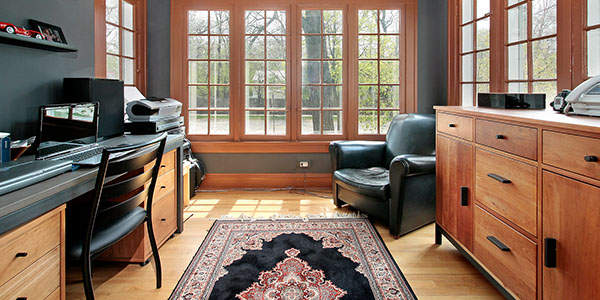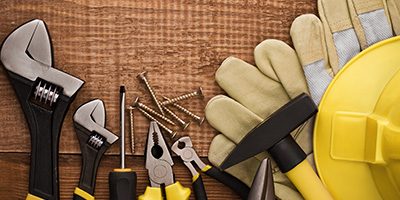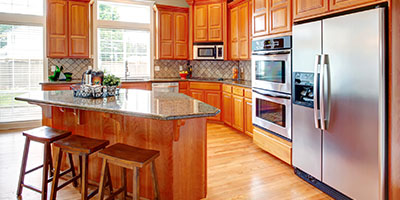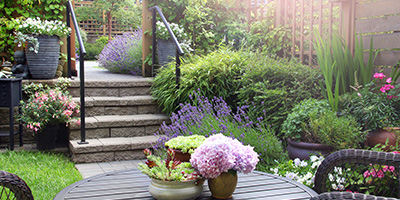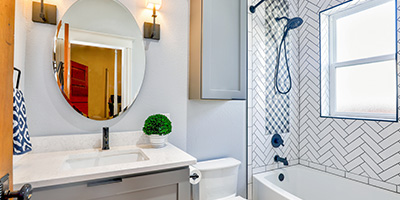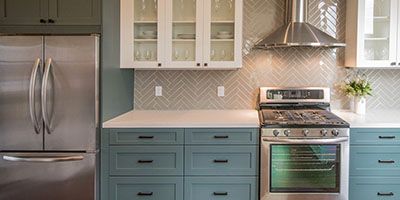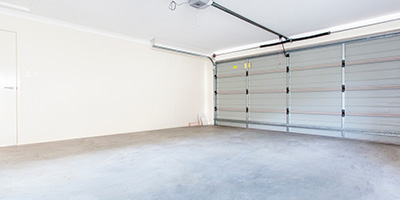How to Set Up a Home Office on a Budget

How to Set Up a Home Office
According to Forbes, more than 4 million U.S. employees work from home. That number continues to climb each year, and those who work remotely are doing so more frequently than ever before.
If you’re part of the growing remote-work population, you may be considering setting up a home office. However, as most people don’t have a large budget to invest in designing an office, this may feel like a daunting task.
To help you get started, we’re sharing functional home office ideas and simple design tips to make your new space feel practical and stylish, without breaking the bank.
Considerations for Designing a Functional Home Office
Decide on a Location and Layout
When setting up a home office for remote work, the first thing you need to do is choose a location in the house. You’ll want to use a room that has enough space, receives plenty of sunlight and is out of the way from high-traffic areas. A few rooms to consider for a home office setup include:
- A spare bedroom.
- A space off of the living room.
- A room adjacent to a backyard entrance or patio.
- A finished basement.
- A second living room or den which you can add doors to.
- A finished attic.
If you concentrate well in a noisier environment, you may also consider a room next to the kitchen instead of the living room.

"The best place for an office is removed from the main action of the home. I usually see them as a separate room near the front door of the home, or as a smaller command center near the back entry of the home. I think it is essential that it has a level of privacy depending on how you plan to use the space. If you’re planning on actually working from home, make sure there are doors on the room to better control sound volume."
Brooke Schall | Interior Designer, KSI
You should also consider what type of atmosphere you want for your home office. Many professionals enjoy an open layout, while breaking up the room with furniture and accessories can give a more high-powered feel to the office. Additionally, you may want to face your desk towards the window to enjoy natural light throughout the day, though you should check for any potential glare from the sun on your computer screen.
Does Your Home Office Match the Rest of Your House?
Now is a great time to give your home décor a refresh so it flows from room to room. Learn how to decorate your home from floor to ceiling.
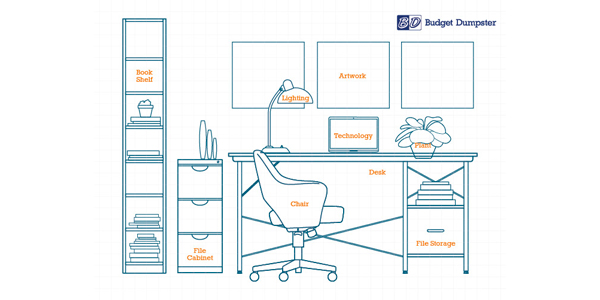
Get Your Home Office Essentials in Order
After you’ve selected and cleared a space to set up your home office, it’s time to pick out furniture and other essentials. Here are a few must-haves for your new workspace, along with tips to improve your home office’s functionality:
- A desk: Make sure you have enough space to work at your desk. There should be plenty of room for your computer and any other materials you’ll need throughout the day.
- Desk chair: When choosing a desk chair, look for one with adjustable height and depth, lumbar support, a backrest and enough cushioning.
- Book shelf and/or file cabinets: Decide if one or both of these storage systems work for you, based off your available space and how many books and papers you have.
- Lighting: Add a mix of desk and floor lamps to the room to set a warm atmosphere.
- Any technology needed for work: This includes a laptop or desktop computer, high-speed internet, a printer, an office phone and any conference or video call equipment.
If you can, choose furniture that’s visually appealing, functional and that complements the style of the rest of your home. To save space in your home office, look for desks with drawers and organizers to store important papers. If you have a limited office design budget, try refurbishing furniture you already have as desks and bookshelves. Online resale groups are another great resource to find inexpensive office furniture.
Award-winning interior designer Kerrie Kelly shares, “A great way to cut costs when creating your home office is to first look around your house. You may be surprised by the amount of items you have that can be repurposed in this space. An extra dining chair can be used as a desk chair. Upholstered? Even better! An old desk, extra lamp and even smaller supplies such as staplers and pens can usually be found right in your own space.”
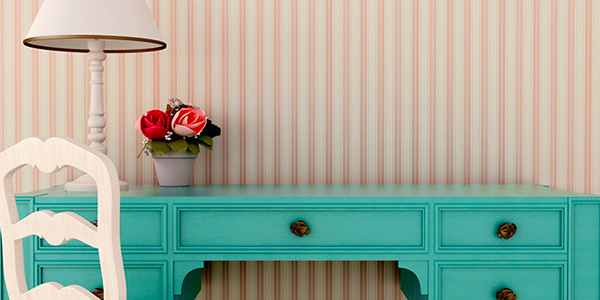
As you think about what tech needs you’ll have in your home office setup, consider a design plan that ensures you have enough power outlets and a way to hide cords and wires around your desk.
With more than 65% of their employees working remotely, the visual collaboration software company Trello is no stranger to expert home office design. Common items you can find in their team members’ home offices include a tablet or laptop, wireless mouse, flat-screen TV or second desktop monitor, noise-cancelling headphones and a fast internet connection for more reliable video calls. “Setups vary from role to role and person to person, but one thing is consistent across the board: We’ve all carved out our own spaces, and we spend a ton of time in them,” shares the Trello team.

"When setting up your home office, make sure you are selecting pieces that are a good fit for your life and work style. Do you have a lot of files? Look for pieces that provide filing drawers with the aesthetic you are going for. You can also dress up a filing cabinet by accessorizing the top with things such as plants, pictures and other decorative items. Do you have a lot of books? Choose to purchase a few bookshelves to store all of your books. The great thing about bookshelves is that they can be mixed in with accessories for a truly curated, designer look."
Kerrie Kelly | Kerrie Kelly Design Lab
Our 7 Best Home Office Setup Tips
1. Brighten Up Your Space
Good lighting is essential for ambiance and staying focused while working from home. Even if you set up your home office in a room with lots of natural light, chances are, you’ll be burning the midnight oil from time to time and will still need lighting.
Desk lamps and standalone floor lamps make it easy to adjust the amount of light in specific parts of the room. They also come in endless sizes, styles and wattages, so you can design your office exactly how you want it. For whole-room illumination, you may consider installing light fixtures on the ceiling or walls as well.

"Light is an important part of a home office, both a natural light source if possible, or lamps that brighten the space. 'Warm white' bulbs are recommended (and the LED versions are great now), rather than 'bright white' or other bulbs that emit an almost artificial or sterile light color."
Brie Weiler Reynolds | Career Development Manager & Coach, FlexJobs
2. Keep Things Organized
The key to setting up a functional home office is to add plenty of storage space. Wall shelving and cabinets are a must-have for binders or books you need to keep handy. You should also invest in containers, drawer dividers, folders and mail organizers to sort papers and supplies.

Space-Saving Idea:
Working with a small home office space? Installing floating shelves and built-in cabinets above your desk is a great way to maximize storage space, without cluttering the room with more furniture on the floor.
Have a defined place to keep everything, and make sure to store personal papers, belongings and bills separately from your office items. Keeping the essentials organized will make it easier to find everything you need throughout the day.

"For most of our projects, we tend to incorporate a custom built-in to an office because it is functional and offers plenty of storage to an office space. Built-ins are an expensive option, but there are ways to mimic the look for less. You can create an illusion of a custom built-in by painting the wall and cabinet the same color. It makes a big impact on a space. It makes the unit look larger, polished and look more expensive than it is."
Heather Scott | Heather Scott Home & Design
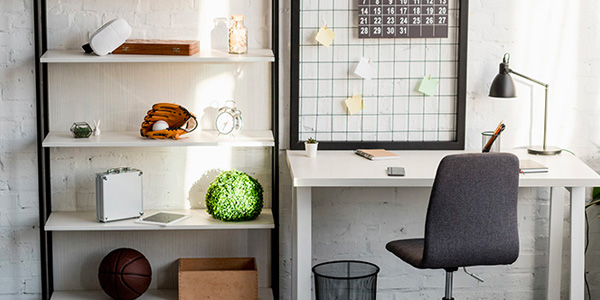
3. Personalize the Office
Having a place for everything (and everything in its place) is a big part of creating a visually appealing office, but decorating is also key to creating a work space that feels inspiring. Painting and changing out window treatments is an easy, inexpensive way to bring new life to the room. Adding artwork, photos and knickknacks will go a long way in making the office feel like your own, too.
Look around other rooms in your home or in storage areas to see if there are any accessories you can bring into the office to save on buying new décor. In addition, placing a few plants on shelves or tables will add brightness to the room. Succulents are a popular, low-maintenance choice for offices, though you can’t go wrong with zero-maintenance fake flowers either.

"If you're going to be doing a lot of video calls, pay attention to the way you set up your home office so you have a great video background and lighting. Try to position your desk and laptop so there's a light source behind that equipment. That way, it lights up your face when you're on camera. Have a clutter-free background behind you so your fellow video meeting mates aren't distracted by your surroundings. A blank wall or one with some artwork or a clutter-free bookshelf work well."
Brie Weiler Reynolds | Career Development Manager & Coach, FlexJobs
4. Plan for Visitors
Will you have teammates or clients coming in to visit at your home office? If your profession requires meeting people throughout the day, make sure they have a comfortable place to sit and work. Depending on how much space you have in the office, you can add upholstered chairs, an end table or a coffee table to host meetings and work collaboratively. A long interior hallway with a bench or chairs can even work as a reception space. Reuse seating options and tables you have in other areas throughout the house for an eclectic look, or check garage sales and online resale groups in your area for a bargain on gently-used furniture.
Repurposing a Bedroom for Your Office or Guest Area?
You’ll need to find a place for all that old furniture. Check out our home decluttering guide for tips on clearing out every room in your home, as well as space-saving ideas to keep your home office looking great.
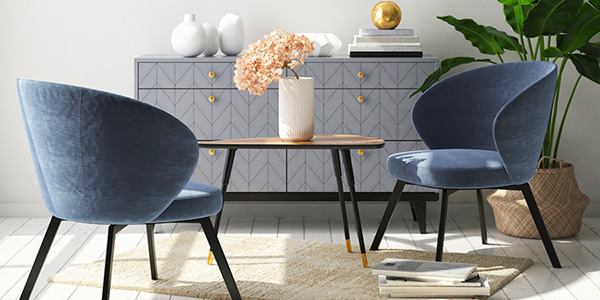
5. Watch the Time
One very practical home office design idea is to hang a clock in the room and keep track of time. You should set working hours for your home office the same way you would in a traditional office space. This is helpful to let clients and co-workers know when you’re available, as well as to let family and friends in the home know when you’re working and should be left alone. This is also beneficial for work-life balance to prevent yourself from losing track of time and overworking.
You can find clocks in the $5 - $20 range at just about any home store, or potentially for free in community resale groups online.

"When creating your home office, try to find used or free items for your home office furniture and furnishings. On Facebook, lots of communities now have "buy nothing" groups where people can offer used items to give away. You can find everything from desks and chairs to lamps, to half gallons of paint that might work to update your office walls, house plants to add some green, fresh energy to the space, and even office supplies like pencils and paper."
Brie Weiler Reynolds | Career Development Manager & Coach, FlexJobs
6. Stock Up on Supplies
To maximize productivity in your home office, have extras of all your office supplies handy. Make sure you have backups of pens, paper, paper clips, staples, printer ink and toner, batteries and any other items you use regularly. To keep your home office shopping on budget, buy basic supplies, such as paper, pens, folders and other small accessories, at your local dollar store over an office specialty store.
If you have space, you may also consider adding a mini-fridge, small coffee maker and snack bar area so you can keep working uninterrupted during the day.

"There are so many ways to re-use household items in your office space. Try using old mason jars for storing items such as pen, pencils, paper clips and more. Wicker or wire baskets can be hung on the wall and become extra storage for paper, magazines, files, etc. A large picture frame with glass can quickly become a monthly calendar with some dry erase markers! The options truly are endless."
Kerrie Kelly | Kerrie Kelly Design Lab
7. Save Your Receipts
If you’re self-employed and your house is your primary place of work, it’s likely that some or all of your related home office improvements will be tax-deductible. Hang onto receipts and chat with a tax expert to find out exactly which projects will save you more come April 15.
If you’re working remotely for a company you don’t own, it’s still worthwhile to hang onto receipts for your initial home office setup, supplies and any tech purchases not provided by your employer. Many companies will reimburse remote workers for certain items.
